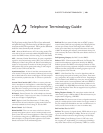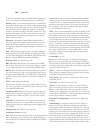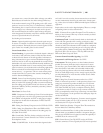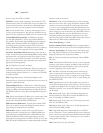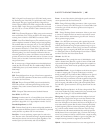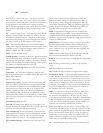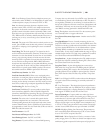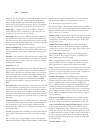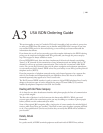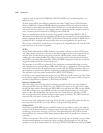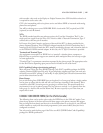GUIDE TO TELEPHONE TERMINOLOGY | 111
interface. Also known as the S passive bus.
S0- European term for ISDN BRI. See BRI and ISDN2.
S2M- European term for ISDN PRI. See PRI and ISDN 30
Sealing Current- Unlike telegraphy, teletypewriter and POTS
lines, most digital lines (such as ISDN) use a voltage rather than
current mode of operation. Sealing Current allows a controlled
amount of current to be passed through a telecom circuit for
purposes of “healing” resistive faults caused by corrosion. Bellcore
specifies sealing current on the ISDN U interface in the USA. e
Siemens EWSD switch does not provide sealing current. Most
other ISDN capable switches used in North America do.
SF- Superframe. A type of Line format supported on T1 circuits.
e Telco determines the line format and line encoding of your line.
ESF is the preferred Line Format on T1 circuits. See Line Format.
Silence Suppression- See Statistical Multiplexing.
SLC-96 – A Subscriber Loop Carrier Circuit system manufactured
by AT&T (now Lucent). SLC-96 has its own version of T1 fram-
ing between it and the CO. SLC-96 and similar “SLIC” systems
may or may not perform a concentration function. e interface
is the Bellcore TR-008 or the newer GR-303 interfaces that are
specialized versions of T1 intended to allow transparent transport
of analog CLASS features such as Caller ID, Call Waiting, etc. e
GR-303 interface is specifically intended to be used as a common
point of interconnection between alternative equipment, technolo-
gies, and/or networks (i.e. voice-over-DSL, voice-over-IP, etc)) and
the public switched network. See the following link for additional
information from Telcordia: http://www.telcordia.com/resources/
genericreq/gr303/index.html
SLIC- 1) Subscriber Line Interface Circuit, see “Line Card”. 2) e
equipment used with the AT&T (Lucent) SLCC Subscriber Loop
Carrier Circuit, a system used to multiplex a number of subscriber
loops onto a single circuit (usually a T1 circuit) to reduce fixed
costs. 3) Also sometimes used generically for other brands of similar
equipment. See also SLC-96.
SPID- Service Profile IDentifier- On the “National ISDN”,
“AT&T Custom PMP” and “Custom DMS” ISDN BRI protocols,
the Telco switch must receive correct SPID(s) from the CPE before
it will allow access to ISDN service. Intended to allow multiple
configurations on ISDN lines shared among different types of CPE
equipment. While your SPID may include your area code and
telephone number, the SPID is distinct from the telephone number.
For the National ISDN, Custom PMP, and DMS custom ISDN
protocols the equipment requires that the user to program SPIDs
into it. Custom PTP and ETS 300 protocols do not require a SPID.
No SPIDs are required for ISDN PRI protocols.
SS7 - Signaling System 7. e internationally adopted Common
Channel Interoffice Signaling (CCIS) system. Previous to SS7
the Bell System used SS6 which did not support the International
tom ISDN and ISDN Protocol.
RBOC- Regional Bell Operating Company. (USA) One of the
regional companies formed when AT&T was forced out of the local
telephone business. Each RBOC (or “baby bell”) owns a number of
the former “Bell Operating Companies”. e Bell Operating Com-
panies are the traditional local phone companies (pre-1984), except
where one’s service is from an “Independent” (non bell) telephone
company or a CLEC. Due to their former association with the
Bell System RBOCs are regulated by the FCC differently than are
independent Telcos or CLECs. In many cases the Bell Operating
Company structure is no longer used. For instance, here in Ohio
we now deal directly with the RBOC, Ameritech, while the old
Bell Operating Company, Ohio Bell Telephone, no longer exists.
Another trend is mergers among the RBOCs (and in some cases
the independents as well). See CLEC and LEC.
RD- Receive Data. Data coming from the network, or DCE
towards the DTE. Also, a light on a modem or CSU/DSU that
lights to indicate presence of this signal.
Red Alarm- An alarm state on a T-carrier circuit that indicates that
the incoming signal (at the network interface) has lost frame for
more than a few seconds. Normally a Yellow alarm is then returned
(i.e. sent back) if a Red alarm is present. A Red Alarm indicates a
loss of inbound signal; a Yellow alarm indicates (indirectly) a loss of
outbound signal. See also Yellow alarm, Blue alarm, and LOS.
Regional Bell Operating Company- See RBOC
Repeater- A device intended to extend ISDN telephone service to
sites further from the central office than could normally be served.
i.e.: beyond 18,000 feet. ISDN repeater technologies include
“BRITE”, “Virtual ISDN”, “Lightspan”, and “Total Reach”. Some
Telcos do not use repeaters. Compatibility between a given NT1
(CPE) and a repeater is less certain than if that CPE where directly
connected to the switch.
Robbed Bit Signaling- A signaling scheme that “borrows” bits on
each T1 channel for use as signaling channels. On SF T1’s there
are two bits, the A bit and the B bit in each direction. On ESF
T1’s there is also a C and D bit in each direction, although they are
rarely used. Using these bits, various older analog trunk interfaces
can be emulated over a T1. For instance, dial pulse address signaling
using 10 pulse per second (rotary style) digit groups over these bits.
Since robbed bit signaling interferes with the least significant bit,
only 7 bits can be used for sensitive data applications, leaving only a
56kbps channel for data applications. See also CAS and CCIS.
Rollover – See Hunt Group
S interface- e electrical interface between the NT1 and the Ter-
minal Adapter or other ISDN equipment. ISDN equipment with
built-in NT1’s do not necessarily provide access to the S interface
(the Zephyr Xstream, Zephyr, ZephyrExpress and Telos TWO
do). Multiple devices can share an NT1 by connecting on the S



